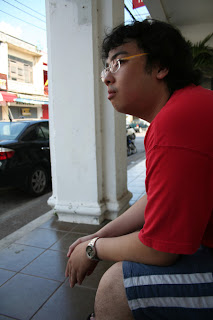Lackluster CompositionSometimes just a subtle shift of emphasis is all it takes to turn a throwaway digital photograph into a treasured keeper. Here are the top tips to immediately improving your composition.
*
Tip 1: The Rule of Thirds The "Rule of Thirds" is a time-honored technique professional photographers use to improve composition. Imagine a tic-tac-toe grid over the image you want to take. Use the intersection of those lines to place your subject slightly off center, and bring interest up or down.
*
Tip 2: Variety Take photos at various angles and distances to give you more options to choose from. Also experiment with vertical and horizontal camera orientation -- you may discover that this simple shift yields interesting results.
*
Tip 3: Reduce the Background Eliminate distracting background clutter by getting closer to your subject. Or try using your camera's Portrait pre-set mode. This will keep objects close to you in focus, while blurring the background. You can achieve the same effect, known as a shallow depth of field, by manually adjusting your aperture setting to a low f-number, such as f2.8.
Poor LightingDigital photography is all about catching that magic moment when the light is just right. But lighting also provides some challenges. These tips will help, whether you're indoors or out.
*
Tip 1: Balance Bight or Dim Light Digital cameras get "confused" by unbalanced conditions, such as a very bright or dim light, causing the camera to under or over expose your photo.
In low light conditions, try using your camera's night shooting mode, or lower the ISO to 50 or 100 to get rich detail in low light. Use a tripod, or steady yourself against a stable object to avoid moving the camera.
In bright light, try your camera's Beach or Sunshine mode, or manually choose a fast shutter speed to control the amount of light that comes in.
*
Tip 2: Shooting Indoors
Avoid using your flash. Instead, provide as much natural light as possible -- open curtains, or even the door. Or use lamps to add light to the scene. Your flash mutes color and casts stark, deep shadows that are especially unflattering in portraits.
Don't place your subject in front of a bright window or they will become a silhouette (although this can be a nice effect when done intentionally). Try placing them off to the side instead, or facing a natural light source.
*
Tip 3: Shooting Outdoors Try to have the sun behind you when you shoot. This will provide the most flattering light to your subject.
Shoot early or later in the day -- dawn and dusk provide lovely light, whereas midday light can be harsh.
Take advantage of overcast days for photography. That's when the light is even, and casts almost no shadows.
Red-EyeThe appearance of glowing red eyes can ruin a portrait of even the cutest child or pet. The red color comes from light reflecting off of the retinas in our eyes. The following quick tips can help get the red out.
*
Tip 1: No Flash: Try not to use a flash if possible -- it is the number one cause of red-eye. Instead, turn on lights or open curtains to add additional light to your scene.
*
Tip 2: Look Away From The Light:
Ask your subject to look toward the camera but not directly at the lens or to look into a bright light first.
*
Tip 3: Use The Red-Eye Reduction Setting: Take advantage of in-camera red-eye removal. Many digital cameras and photo printers now allow you to remove red-eye or prevent it altogether. Check your digital camera's manual to see if it includes these features.
Blurry PhotosWhile a photo with a dramatic blur can often be artistic, it can also render a subject incomprehensible. Here are some ways to add clarity to your digital photographs.
*
Tip 1: Reduce Shutter Lag The time between pressing the trigger and the camera taking the picture is called shutter lag, and it can cause blurry pictures. Avoid it by pressing the trigger halfway down until you're ready to shoot. When the right moment comes, press the rest of the way. This strategy is great when you're taking pictures of people (especially kids) or animals. ?
* Tip 2: Minimize Camera Shake Even the slightest camera movement can cause unclear photos. Use a tripod or brace yourself against a stationary object to hold the camera still. Some digital cameras come with image stabilization, another way to get clear images of moving subjects.
* Tip 3: Use "Action" Mode Use your digital camera's "Action" shooting mode for sports or other action shots. It automatically optimizes your shutter speed to help capture motion. Or manually increase your camera's shutter speed to achieve the same effect.
Low-Quality PrintsIf you plan to print your photographs using a digital photo printer, keep resolution in mind. Resolution is measured in megapixels (MP), and matching the resolution to the print size will help you get clear digital photo prints.
*
Tip 1: Use High Resolution If you plan to enlarge or crop photos before printing, it's best to shoot at the highest resolution possible. But high-resolution pictures take up more memory.
*
Tip 2: Low-Res for Email If you plan to e-mail images or print smaller sizes, like 4" x 6" or 5" x 7" photos, you can stick to 4-5 MP with no problems.
* Tip 3: Many digital cameras let you select the resolution level, so you can determine ahead of time whether you want to shoot a big file with lots of detail, or a quick snapshot you can post to a website or e-mail to friends and family.

